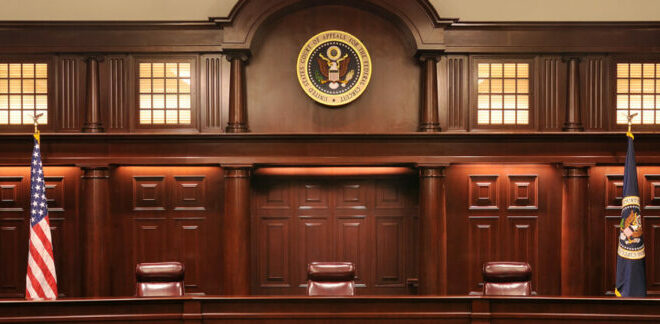“If a court reverses or vacates a judgment upon which a collateral estoppel decision is based, then collateral estoppel can no longer apply based on that decision.”- CAFC
 The U.S. Court of Appeals for the Federal Circuit (CAFC) issued a precedential decision on Friday vacating-in-part a district court decision that granted SonicWall, Inc. summary judgment of invalidity based on a collateral estoppel decision that the CAFC had since vacated. Judge Bryson concurred in part and dissented in part, disagreeing with the majority’s analysis affirming the district court’s grant of summary judgment of noninfringement as to the claims of certain patents.
The U.S. Court of Appeals for the Federal Circuit (CAFC) issued a precedential decision on Friday vacating-in-part a district court decision that granted SonicWall, Inc. summary judgment of invalidity based on a collateral estoppel decision that the CAFC had since vacated. Judge Bryson concurred in part and dissented in part, disagreeing with the majority’s analysis affirming the district court’s grant of summary judgment of noninfringement as to the claims of certain patents.
Finjan, LLC sued SonicWall for infringement of its U.S. Patent Nos. 8,677,494, 6,154,844, 6,804,780, and 7,613,926 (collectively, the “Downloadable Patents”), as well as U.S. Patent No. 8,225,408 (the “ARB Patent”). Two of those patents—the ’780 and ’844 patents—were found invalid for indefiniteness in related CAFC proceedings last November. SonicWall filed a motion seeking judgment of invalidity as to the asserted claims of the ’780, ’844, and ’494 patents due to collateral estoppel based on the November decision, and the district court agreed, granting judgment of invalidity due to collateral estoppel and indefiniteness as to claims of the ’844, ’780, and ’494 patents.
During claim construction, the parties agreed that “Downloadable” means “an executable application program, which is downloaded from a source computer and run on the destination computer,” according to the CAFC opinion. SonicWall moved for summary judgment of noninfringement based on this definition, arguing that its Gateway products never receive “Downloadables”—“executable application program[s]”—but instead “receive and inspect packets without extracting the data or reassembling the file within,” and therefore could not infringe those claims. The district court agreed that Finjan failed to present evidence that the accused products “ever possess a reassembled file or executable application” and granted summary judgment of noninfringement.
The district court also granted summary judgment of noninfringement as to the ARB patent, finding that the accused products “involve separate, remote computers,” and it was determined that the recited claim limitations “must be performed by the same computer.”
On appeal, Finjan: 1) challenged the judgment of invalidity based on collateral estoppel, 2) sought to reverse the judgment of noninfringement, arguing that “receiving packets that contain a downloadable or portions thereof constitutes receiving a downloadable,” 3) alleged that “multiple computers can collectively perform the ‘by a computer’ or ‘by the computer’ limitations as to the ARB patent, and 4) argued the district court abused its discretion in striking Finjan’s expert apportionment analysis.
On the first point, the CAFC explained:
“For patent claims, collateral estoppel applies where the ‘issues of patentability’ are identical, i.e., where ‘the differences between the unadjudicated patent claims and adjudicated patent claims do not materially alter the question of invalidity.’…. If a court reverses or vacates a judgment upon which a collateral estoppel decision is based, then collateral estoppel can no longer apply based on that decision.” [citations omitted]
Thus, the previous decision in Finjan LLC v. ESET vacating the judgment upon which application of collateral estoppel was based necessitates vacating the judgment of invalidity here, said the CAFC. “We cannot uphold applying collateral estoppel based on a vacated judgment,” the opinion explained.
As to noninfringement, the CAFC agreed with SonicWall that the district court’s judgment flowed from the parties’ agreed-upon claim construction that was derived “verbatim from the definition of ‘Downloadable’ in the ’844 and ’780 patents’ specifications.” Since “[w]e do not permit parties on appeal to raise claim construction arguments challenging a stipulated construction,” the CAFC ultimately affirmed the grant of summary judgment of noninfringement.
The appellate court also agreed with SonicWall and the district court as to the ARB patent, holding that “the plain language of the claims requires at least one of those computers to perform all the functions listed in the claims of the ARB Patent,” and thus granting the summary judgment of noninfringement as to those patents as well.
Finally, the CAFC found that the district court did not abuse its discretion in excluding Finjan’s expert apportionment analyses because the record showed that “Finjan’s expert failed to carefully tie his analysis to allegedly infringing features and to exclude value attributable to unpatented features.” Finjan attempted to rely on the CAFC’s ruling in Finjan, Inc. v. Blue Coat Systems, Inc. to argue that the expert’s methodology satisfied the apportionment requirement because the expert there was permitted to offer similar analysis of top-level features. But the CAFC said Blue Coat is inapposite because the portion of the decision on which Finjan was relying concerned “whether a jury’s damages award was supported by substantial evidence… whereas this appeal concerns the district court’s discretion to strike Finjan’s expert apportionment analyses before it went to a jury.”
The district court decision was thus affirmed-in-part, vacated-in-part and remanded.
Judge Bryson explained in his partial dissent that he would not have affirmed the judgment as to the Downloadable patents because he disagreed with the district court’s construction.

![[IPWatchdog Logo]](https://ipwatchdog.com/wp-content/themes/IPWatchdog%20-%202023/assets/images/temp/logo-small@2x.png)

![[Advertisement]](https://ipwatchdog.com/wp-content/uploads/2024/04/UnitedLex-May-2-2024-sidebar-700x500-1.jpg)
![[Advertisement]](https://ipwatchdog.com/wp-content/uploads/2024/04/Patent-Litigation-Masters-2024-sidebar-700x500-1.jpg)

![[Advertisement]](https://ipwatchdog.com/wp-content/uploads/2021/12/WEBINAR-336-x-280-px.png)
![[Advertisement]](https://ipwatchdog.com/wp-content/uploads/2021/12/2021-Patent-Practice-on-Demand-recorded-Feb-2021-336-x-280.jpg)
![[Advertisement]](https://ipwatchdog.com/wp-content/uploads/2021/12/Ad-4-The-Invent-Patent-System™.png)






Join the Discussion
No comments yet.